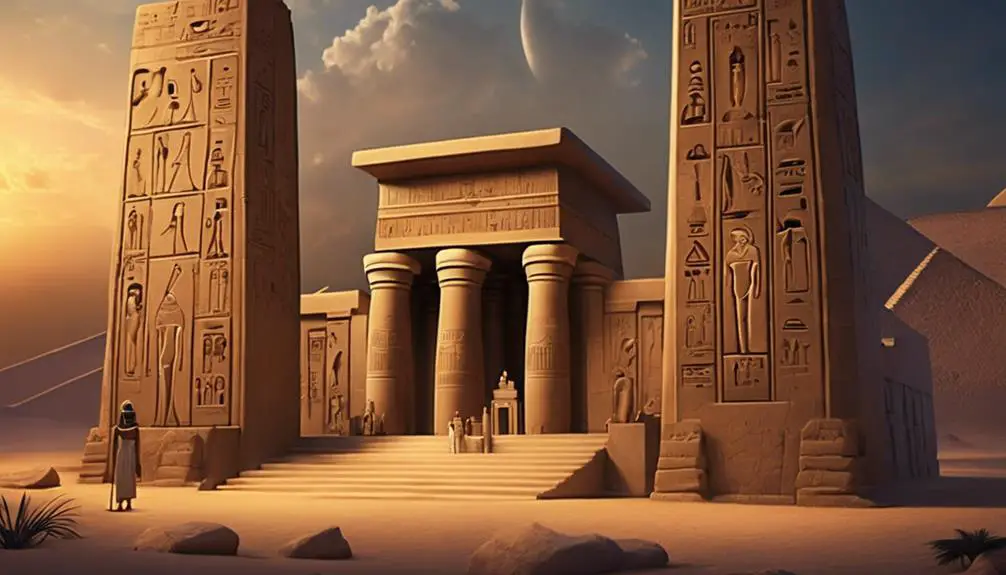Origins of Hypnosis Timeline
5 Ancient Origins of Hypnotism Practices
May 8, 2017 - Origins of Hypnosis Timeline
The ancient origins of hypnotism practices trace back to Egyptian Sleep Temples using altered consciousness for healing. Greek Dream Incubation sought guidance through dream interpretation. Hindu Yogic Trance explored self-discovery and enlightenment through deep meditative states. Chinese Hypnotic Techniques integrated with traditional medicine for holistic well-being. Mesmer's Animal Magnetism theories influenced modern psychological therapies. Unveiling these ancient civilizations' contributions offers unique insights into the use of altered states for spiritual transformation and healing.
Egyptian Sleep Temples

The origins of hypnotism practices can be traced back to the ancient Egyptian Sleep Temples, where a form of healing through altered states of consciousness was utilized. These temples served as centers for ritualistic healing and spiritual enlightenment, where individuals sought relief from physical ailments and guidance for their spiritual journeys.
Within the walls of these sacred temples, priests would induce a trance-like state in individuals through various methods such as chanting, music, and visualization techniques. Once in this altered state, individuals were believed to be more receptive to healing energies and divine messages.
The practice of hypnotism in these temples was deeply intertwined with the belief in the power of the mind to influence the body and spirit. Through the manipulation of consciousness, individuals could access deeper layers of their being, leading to profound insights, emotional release, and physical healing.
The Egyptian Sleep Temples laid the foundation for the use of hypnotism as a tool for healing and transformation, setting the stage for its evolution and widespread adoption in various cultures throughout history.
Greek Dream Incubation
How did the ancient Greeks utilize dream incubation as a method for seeking guidance and healing?
Greek dream incubation was a practice deeply rooted in healing rituals and spiritual guidance. Individuals seeking answers or cures would spend the night in a sacred space, often a temple dedicated to a healing deity like Asclepius. Through rituals, prayers, and sometimes fasting, these seekers would prepare their minds for the divine messages they hoped to receive in their dreams. The belief was that the gods would visit them during sleep, offering insights, prescriptions, or guidance on their ailment or question.
These healing rituals were not merely about physical wellness but also encompassed spiritual and emotional healing. By connecting with the divine realm in their dreams, individuals sought holistic well-being.
The process of dream interpretation was crucial, with priests or healers deciphering the symbolic messages to provide the seekers with a roadmap for their recovery or next steps in life. Greek dream incubation thus served as a profound method for individuals to tap into the spiritual realm for guidance and healing.
Hindu Yogic Trance

Utilizing deep states of meditative trance, Hindu yogic practitioners engage in a transformative spiritual practice aimed at expanding consciousness and unlocking inner wisdom. Through the practice of deep meditation, individuals enter altered states of consciousness that allow for profound self-discovery and spiritual awakening.
In Hindu yogic traditions, the concept of trance is deeply intertwined with the exploration of one's inner self and connection to the divine. By delving into these deep meditative states, practitioners seek to transcend the limitations of the physical world and tap into the boundless realm of spiritual knowledge and enlightenment.
The journey into Hindu yogic trance is a path towards unraveling the mysteries of the self and understanding the interconnectedness of all things. It is a practice that requires discipline, dedication, and a willingness to let go of preconceived notions in order to fully embrace the transformative power of altered consciousness.
Through this process of self-exploration, individuals can unlock hidden truths, cultivate inner peace, and ultimately experience a profound sense of unity with the universe.
Chinese Hypnotic Techniques
Across the rich tapestry of ancient practices, Chinese Hypnotic Techniques stand out as intricate methods that delve deep into the realms of consciousness and suggest profound insights into the human psyche. With a historical evolution dating back thousands of years, these techniques have been deeply intertwined with Chinese culture and philosophy.
The therapeutic benefits of Chinese Hypnotic Techniques are well-documented, with practitioners using methods such as guided imagery, progressive relaxation, and focused attention to help individuals overcome various psychological and physical ailments.
In modern applications, Chinese Hypnotic Techniques continue to hold cultural significance, offering a unique perspective on the mind-body connection and promoting holistic well-being. These techniques are often used in conjunction with traditional Chinese medicine practices to enhance treatment outcomes and promote overall health.
The deep-rooted history and therapeutic efficacy of Chinese Hypnotic Techniques make them a valuable resource in the realm of alternative medicine, providing individuals with new avenues for healing and self-discovery.
Mesmer's Animal Magnetism

In the exploration of hypnotic practices, Mesmer's Animal Magnetism emerges as a fascinating phenomenon that captivated both the scientific community and the general public during the 18th century. Developed by Franz Mesmer, a German physician, Mesmer's theories on animal magnetism, also known as mesmerism, proposed the existence of a natural energetic transference occurring between all living beings.
Mesmer believed that imbalances in this magnetic fluid within the body led to various ailments, and through his techniques, he aimed to realign these energies to restore health. Mesmer's practices involved inducing trance-like states in individuals through gestures, passes, and the use of magnets, with the goal of rebalancing their internal magnetic forces.
Despite facing skepticism and controversy from his peers, Mesmer's work laid the foundation for modern hypnotism and influenced the development of psychological therapies. The concept of animal magnetism, although viewed differently today, remains a significant chapter in the history of hypnotic practices, reflecting the enduring curiosity and intrigue surrounding altered states of consciousness.
Frequently Asked Questions
How Did Ancient Civilizations Understand the Concept of Hypnosis?
Historical perspectives and cultural interpretations shed light on how ancient civilizations understood hypnosis. Exploring psychological implications reveals its therapeutic benefits. Understanding these aspects can deepen our appreciation of the ancient roots of hypnosis practices.
Are There Any Modern Applications of These Ancient Hypnotism Practices?
Modern applications of ancient hypnotism practices offer therapeutic benefits for managing various conditions like anxiety, phobias, and chronic pain. Additionally, performance enhancement through hypnosis is utilized in sports, public speaking, and creative endeavors to optimize mental focus and confidence.
What Role Did Religion Play in the Development of Hypnotism?
Religious influences have historically played a significant role in the development of hypnotism, shaping cultural interpretations and practices. Various belief systems have contributed to the understanding and application of hypnotic techniques throughout history.
Were There Any Ethical Considerations in the Use of Hypnotism?
Ethical boundaries surrounding hypnotism have evolved over time, influenced by historical context, cultural perceptions, and societal norms. Practitioners must navigate these complexities to ensure safe and respectful use of this powerful therapeutic tool.
How Did These Ancient Practices Influence Modern Hypnotism Techniques?
Cultural influences and historical techniques have shaped modern hypnotism. The evolution of hypnotism from ancient practices has had a profound impact on therapy. Understanding these roots helps practitioners refine techniques and enhance therapeutic outcomes.
Conclusion
In conclusion, the ancient origins of hypnotism practices reveal the long history and diverse cultural influences of this unique therapeutic technique.
From the Egyptian Sleep Temples to Mesmer's Animal Magnetism, hypnotism has evolved over centuries and across civilizations.
By understanding the historical foundations of hypnotism, we can appreciate its significance and relevance in modern psychological and medical practices.
